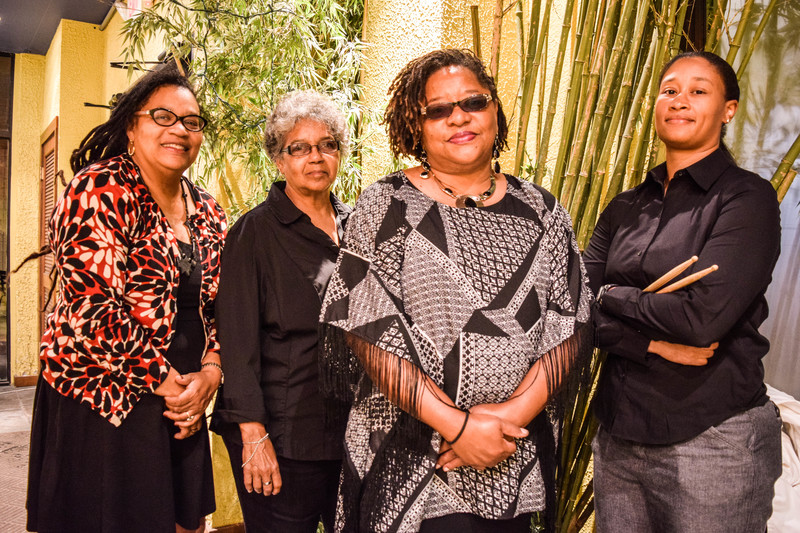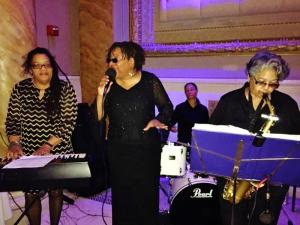It is Christy Taylor’s final lesson of the night. For the other woman sitting at the keyboard, it is the first of many. As she pushes her fingers onto the instrument with Taylor’s instruction, the sun ducks, sooner every evening as autumn crawls in. A last-of-the-summer warmth clings outside. In the studio, sounds of lightly pressed keys, hesitation and purpose, some kind of beginning, emerge.
The woman had phoned Taylor, a teacher, music director, and member of Shades of Blue, earlier in the day with unfettered determination to learn piano. And here she was, fingers awkwardly hitting keys, trying to connect, to find C, then B, then A. Both women know piano is beyond a mere plunking of fingers on white and black – it is learning another language and all the grays in between those 88 keys.
Taylor had performed just a few nights earlier, when Shades of Blue performed at the Cultured Pearl. The lights set to a soft glow, tables packed with sushi, and diners dressed pretty in button-downs and lipstick and tipsy smiles, the night was wrapped around a stage with four women: Taylor at her keyboard, performing the nostalgia-inducing scat that is jazz. Elaine Foster flooded the stage with her voice, eyes closed and head bowed at each phrase. An all-female group, which Taylor says was unintentional, Shades of Blue is almost 30 years in the making. They do jazz, blues, and R&B best.
The four-piece band used to be a duet back in 1986 with just Taylor and Foster. The two met at Delaware State University. Taylor had been planning to study sociology, but word got out she played trombone, and by the time freshman orientation arrived, she was signing up for music.
“My head was spinning,” Taylor said. “Like, I’m going to be a music major.”
Three decades into the arduous and equally rewarding lives of successful musicians, the two women of Shades of Blue have picked up several members, male and female, who came and went. But drummer Cherisse Taylor and saxophonist Stephanie Shelton have stuck, both for their commitment and talent.
The four focus on straight ahead jazz, those 1930s and '40s euphonic brocades like the music of Duke Ellington and Taylor’s favorite, Billie Holiday. They play to the timing – classical for dinner and Motown when it’s time to dance. And they always put a twist to it.
It’s one of Taylor’s favorite things about jazz, the constant allowance to improvise. They’ll play the original sound – think “Somewhere Over the Rainbow” – but the second time is unrecognizable – think altering the audio theme along with skiddleebop and other nonsense syllables that make perfect sense to the rhythmic ear.
“We have a conversation between the musicians,” Taylor says. The singer will begin the story, the sax will add to it, and the piano will respond. It’s an exchange of ideas, of building and restructuring, from the intent to the mood to how fast or slow, fun or melancholy.
And after that conversation?
“I told my story about it,” Taylor says, “now let’s get back to the theme and get out.”
The colors of Taylor’s accomplishments have not dulled as Shades of Blue has matured. She’s filled many roles, from teaching fifth-grade bands to conducting the Harlem Festival Orchestra for four seasons, 1998-2002. She is music director for Shiloh Baptist Church in Wilmington and also teaches music and culture – though one could call it culture through music – to youth groups.
“I have a fascination with culture,” Taylor says. “I find it exciting that God has allowed the world to spin with so many differences.”
But it’s also finding the similarities within distinct cultures. And that is what Taylor accomplishes through her lessons. She has an African drum and dance group, which exposes young people to the continent’s cultures. If this is the makeup of the school, Taylor says, then why not learn about it? If there is a large Guatemalan presence in Georgetown, why not take the time to soak in their unique humanity? When there is a whole culture in one small area of one small state, there is an extremely tangible opportunity to learn, and with learning comes acceptance and connection.
Taylor aims to model to young people that it’s OK to not like something, but disliking something doesn’t have to mean rejecting a particular culture.
“I’m sure there’s a way to take the fear out of people who don’t look like you,” she says.
Music is her way, and teaching young people music and its ethnographic effects is what Taylor does. But most recently she’s had success with a couple who are a bit older than what one might consider youthful – 85 years old and a recent stroke survivor, to be exact. He came in with his wife: he wanted to play harmonica; she, the guitar.
“They’re doing well because they’ve carved the time out for it,” said Taylor. “That’s very satisfying for me. I just happen to be the guide – you’re putting in the real work.” She can give lessons and point to helpful exercises and songbooks, but then it's up to the person to find the necessary mindset and commitment. Her business’s mantra is “Where music excellence begins.”
“No one wants to hear mediocre,” said Taylor, and those three to four minutes of real-time performance are the very short end result of hours of practice, of pushing oneself away from saying, “I’m too old.”
“It’s either you do well or get frustrated and give up,” she said. “You’re never too old.”
Shades of Blue will perform from 6 to 9 p.m., Sunday, Oct. 18, at the Cultured Pearl. They are also opening for Taylor’s brother, Bryan Stevenson, the founder of the Equal Justice Initiative and speaker for the First State Community Action Agency Annual Dinner on Monday, Nov. 16 in Dover, where the organization will celebrate 50 years of service to low-income Delawareans.























































